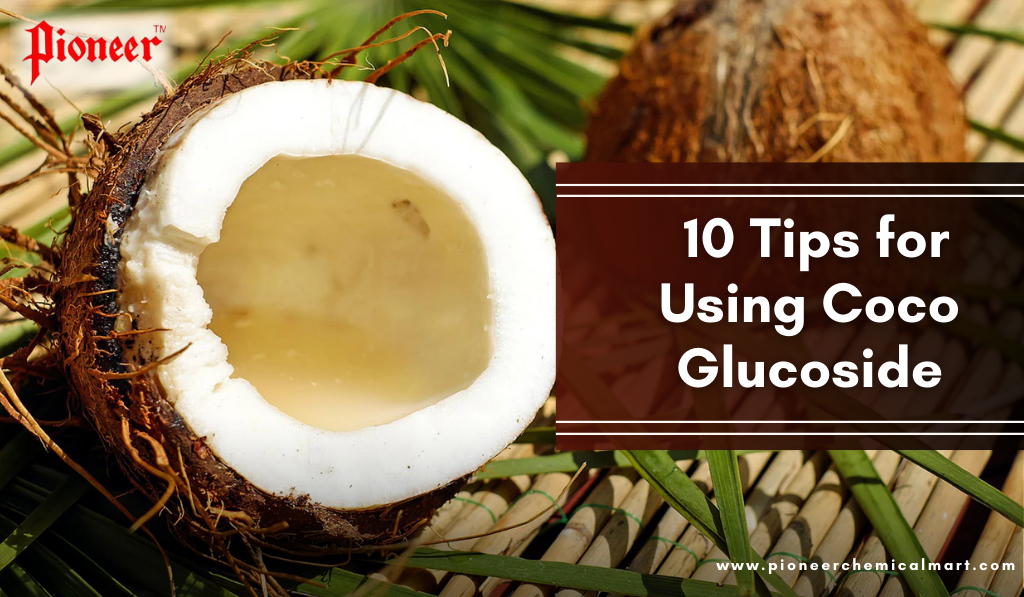10 Tips for Using Coco Glucoside
- BY prashant
- No Comments

Coco glucoside is a mild surfactant used in the Cosmetic industry for its numerous applications and compatibility in formulations such as shampoos, body washes, face washes, and so on. It is derived from coconut oil and fruit sugars which makes it a mild and very effective cleanser.
Due to our status as a leading manufacturer, we often field questions about the optimal applications for this additive. So here we share 10 tips for formulators and manufacturers using this product for creating formulas and products. With these tips and recommendations, you can fully maximize the use of this wonderful natural surfactant.
Tip 1: Use Optimal Concentrations
Make sure to ensure that you use the right concentration of each raw material to ensure the best result in the final product. When compounding with coco glucoside, the right concentration must be incorporated in the formulation. If you want to achieve the best cleansing and foaming properties, we suggest adding this product at a percentage directed by the scientists according to the weight concentration to your formulation. Under usual circumstances, it would be most effective to maintain the retrieval rate at 10% and going above this is not beneficial and expensive. It is generally suggested to start at 5% and then make necessary changes based on the overall performance.
Tip 2: Surfactant Note
You should mix the specific surfactant with other surfactants – however, coco glucoside works well as a solo surfactant. It is often used in conjunction with secondary surfactants such as decyl glucoside, lauryl glucoside, etc. Sometimes, the actual product should range from 5% to 7% while the secondary surfactant should range from 1-3%.
Before using hard water to make soap, you should drain the water to make sure that the calcium and magnesium ions do not interfere with the soap making process. Being a surfactant used in cleaning, its effectiveness in cleansing may be hindered by water hardness in various locations. Nonetheless, it is more efficient in soft to moderately hard water conditions. When applied in hard water an enhanced surfactant such as disodium EDTA can be added to enhance the efficiency in removing greases and oils.
Tip 4: Maintaining pH
pH correction is another vital function that is critical to be done appropriately. It is crucial to control the pH in the process for preparations. It demonstrates the greatest stability and bactericidal action within a pH range of 4 and 6. Raising the value more than 6.5 may lead to a decrease in the lather and skin irritation. This product is another example of how citric acid can be used in formulations to adjust the pH of the final solution.
Tip 5: Improve Foaming
This natural surfactant cleans very effectively but it results in production of moderate foam compared to other sulfated surfactants. It has been observed that the lather can easily be increased by adding foam boosters such as lauramide DEA, cocamide DEA etc., the concentration of which can vary between 1-3%. This is a ratio between the capacity to clean a surface and the amount of foam produced.
Tip 6: Consider Thickening
Typically, coco glucoside formulations possess a thin, watery texture in appearance. Other thickeners that may be used include xanthan gum, hydroxyethyl cellulose and salts of polymers to enhance the viscosity and the feel of the product. Initial the contribution of thickener to a minute percentage and then vary the same.
Tip 7: Blending
This is where you should give consideration to blends and emulsions – mixing this product with other vegetable derived emulsifiers such as glyceryl oleate, and sorbitan olivate forms great quasi-emulsions with good stability and skin feeling. It also helps to control the amount of lather, viscosity, and mildness of the soap blends as well.
Tip 8: Add Conditioning Agents
Conditioning agents are other important substances that can be incorporated into formulations to impart specific conditioning properties to the final product. As this product is a good cleanser, incorporating extra moisturizing agents such as cationic guar polymers enhances the condition of the skin and the feel of the skin after washing. Thus, it is relevant to search for conditioning agents which would effectively enhance the cleansing action of the detergent while not forming a deposit on the fabrics.
Tip 9: Preservation
In order to control the oxidation of fats, oils and proteins, make a decision on the preservative requirement of the product. Similar to other water-in-water emulsions, this product formulation also requires large antioxidant packages for controlling microbial activities. In relation to the specific blend being used, the normal preservative levels consist of between 0.5 – 1 percent. Maintain assertion on preserved systems to guarantee the strength and solidity of guarantee.
Tip 10: Perform Challenge Tests
When coming up with any formula for coco glucoside, it is advisable to carry out a challenge test, or a stress test before arriving at the final product. It is recommended to check such characteristics as stability at low and high temperature, resistance to contaminants or microorganism, changes over shelf life of a product, etc. This will guarantee that your formula will be fine even under the conditions of production, storage and shipment.
Conclusion
Coco glucoside is an anionic surfactant that belongs to the group of glycosides derived from coconut oil and has multiple uses in the cosmetic industry. By adhering to these guidelines, and by using the formulation tips outlined above, it is possible to create products with excellent performance characteristics when this product is used at optimum levels.
Remember – the above listed tips may vary from product to product, and consulting your scientists is the best option. Further questions and to buy – contact us at Pioneer Chemicals. We are always pleased to make sure our customers succeed with our products!
